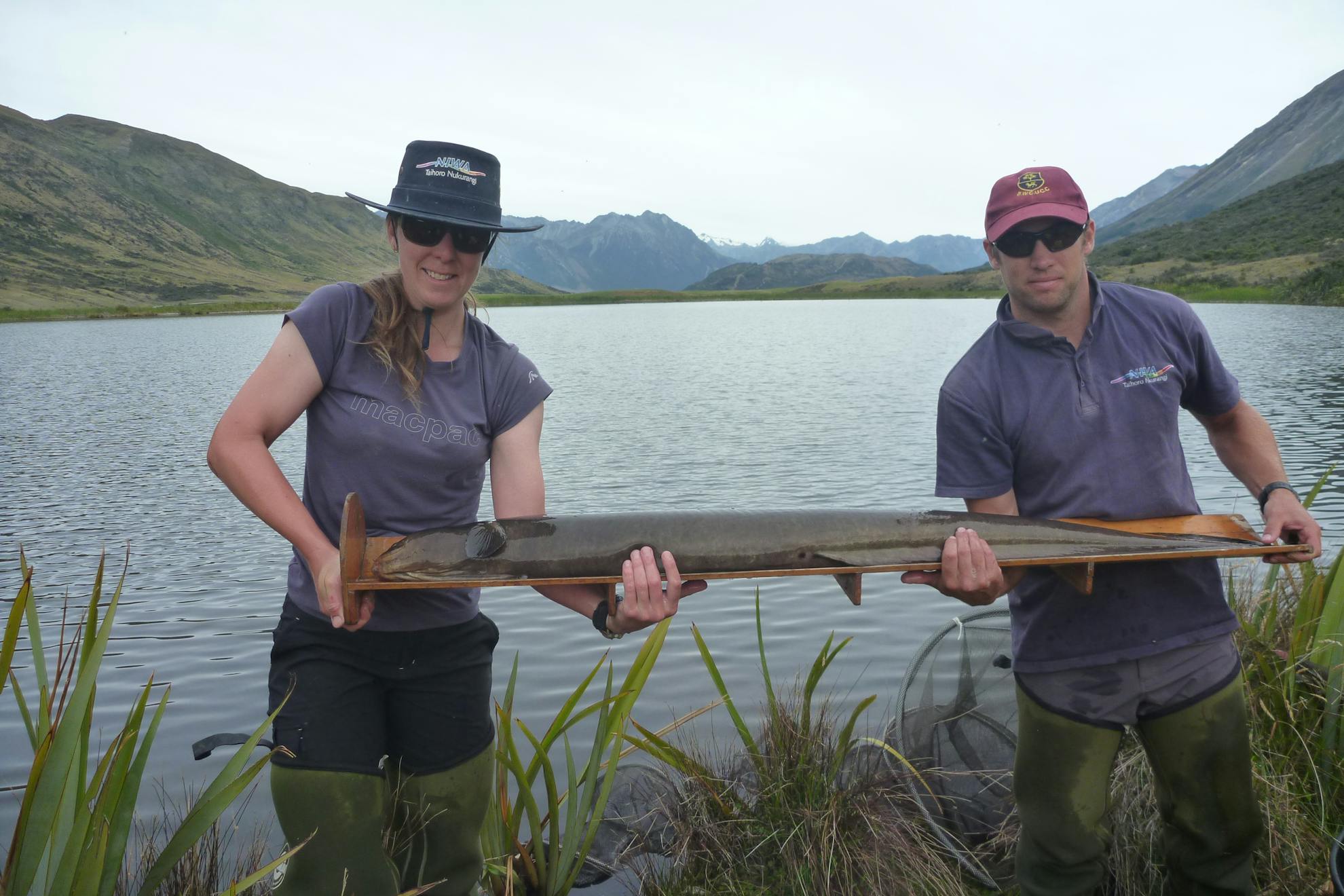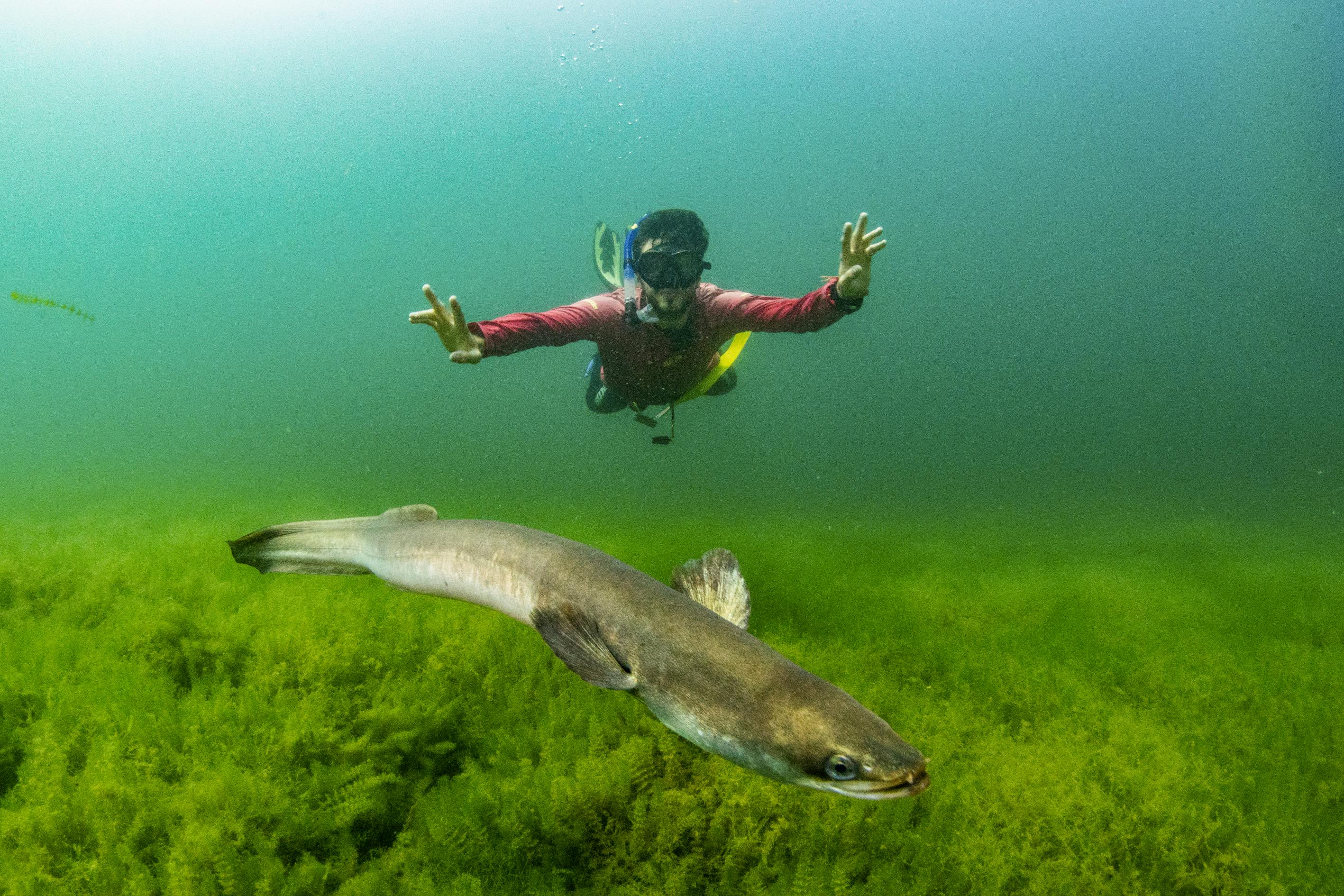The longfin eel is common in the lakes and rivers of New Zealand, but much of its life cycle remains a mystery to science.
In the dark cold of Lake Rotoiti, the serpentine longfin eel prepares for her final journey.
For 80 years, she’s prowled the lake’s depths, stalking fish, koura and ducklings. At well over a metre in length, she has long ago grown into her role at the top of the food chain.
Her eyes, once small and beady, have become large, orb-like, with an ocean blue ring surrounding the pupil, and her head has elongated to a point, hydrodynamic and sleek – she is ready to breed.
As the rains of autumn begin to fall, swelling lakes and rivers, the longfin sets off on her final swim. But to where, no one knows.
The longfin eel is the most revered of all New Zealand freshwater fish species, and with good reason.
Females can live a century or more and reach two metres in length – although fishermen will tell you that is conservative.
Renowned for their generous measuring tapes, Kiwi anglers have long traded questionable accounts of eels reaching up to 3m in length, with heads the size of a labrador’s.
Eel bites make local newspapers every summer – our freshwater ‘sharkmania’ – while legendary tales persist at backyard swimming holes and murky creeks.
In Māori culture too, the longfin holds an esteemed place in legend and in life.
The species was born of the slippery giant Tunaroa, father of all eels, who was hacked to pieces by Maui for insulting his wife. Tunaroa’s head was tossed into the sea, where it gave rise to marine eels, while its tail spawned freshwater species – the longfin and shortfin eels. Its blood spattered across the forest, lending a vibrant splash of red to several species, including pūkeko, kākāriki, rimu and tōtara.
In modern science, the longfin eel has captivated scientists, too.
NIWA freshwater ecologist Paul Franklin says the unsolved mysteries of the eel’s life cycle remains one of the holy grails of fish biology.
Scientists have learned when longfin eels depart New Zealand for their spawning ground in the Pacific, and when their offspring return to our shores, but relatively little is known about the journey in between.
“Eels always fascinate people – they will come across them as kids playing in streams and drains, and I don’t think anyone realises how old they get or how far they have travelled,” Franklin says.
Even scientists are happy to admit they know little about where and how longfin eels breed, and to this day, it has never been observed.
A study conducted in the early 2000s came closest to unravelling the mystery when it successfully tracked an eel 2500km – and many months of swimming – from New Zealand.
In an attempt to fill in the gaps, a team at NIWA, including Franklin, tagged and released 20 migrant eels in May in the hope of tracking them to their spawning grounds.
A lot can go wrong for a fish crossing thousands of kilometres of open ocean, from predation to fishing nets, and scientists can do nothing but wait anxiously for results.

The tags, hooked onto the eel’s skin, continuously measure location, depth and light exposure, and are set to ‘pop off’ at different intervals during the eels’ journey.
Once popped off, the tags will float to the surface and transmit the data to NIWA, hopefully providing a data trail leading to the spawning grounds.
The missing link will provide the next step in the curious life cycle, which begins and ends at a mystery location in the Pacific where the mature eels die after reproduction, leaving the larvae to float back to New Zealand on ocean currents, before swimming and climbing deep into the river systems and lakes.
“Baby eels, or elvers, are fantastic climbers, and longfin eels do a good job of penetrating a long way inland – they can climb big waterfalls as well,” Franklin says.
Dams cause a much bigger obstacle to the elvers, which are usually able to climb steep terrain using surface tension.
“It’s relatively easy to capture elvers as they migrate upstream, as they aggregate at the bottom of dams,” Franklin says.
“But when they’re mature and they start migrating downstream again, their only pathway is through hydro turbines, and you can imagine what sticking an eel in a blender is like.”
Franklin says it’s an ongoing challenge to provide the knowledge to better manage and conserve data-deficient species.
“Trying to make well-informed management decisions can be difficult when you don’t know much about something – it’s a continuous challenge to try and figure out the most important things as quickly as you can, but very often the more you look, the more complicated you find things are.”
Freshwater ecologist Mike Joy says the longfin eel is the second-fastest declining freshwater fish species in New Zealand, and it’s facing a perfect storm of threats.
Despite its classification as an at risk, declining species, it’s still subject to commercial and recreational fishing.
As international eel species are pushed to the brink, demand for our exported taonga is on the rise, Joy says.
Commercial catch is around a fifth of what it was 20 years ago. “It’s reduced because we can’t find them anymore,” Joy says.
The catch per unit effort method of measuring catch is also misleading, Joy says. If you’re catching the same number from the same location every day, it is possible to more accurately gauge the abundance of a species. With eel fisheries, the catch unit doesn’t change, but the location does.
“If you can imagine this over a landscape, you keep fishing in a new place every day, until one day there is none left [anywhere],” he says.
Hydro turbines, irrigation pumps, habitat loss, and recreational angling are also closing the net on the species, and the eel’s monster reputation isn’t doing it any favours.
“I was as guilty as anyone of being a young kid killing eels. They scared me, and it was the macho thing to do. It’s about getting past that attitude.”
With the fate of the species largely in our hands, the eyes of eel conservationists worldwide are fixed on some 20 eels swimming somewhere in the Pacific.
Their secrets just might hold the key to a species on a slippery slope.








